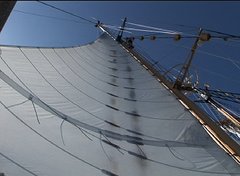We've just passed our halfway day for Stanford@SEA 2017. As a veteran of over 100 oceanographic voyages, some of them nearly 3 months long, I can tell you that such days are always cause for comment and sometimes cause for celebration. The halfway day is most often called hump day, suggestive of a certain eagerness to soon be done with the sea and all that voyaging upon it entails. Not so the mood on the Robert C. Seamans. The occasion of our halfway day has mostly been met with incredulity at the speed with which our time at sea together is passing. Our students are mindful of how much class work lies ahead and the diminishing hours available to complete assignments. Yet we also anticipate great adventuring in the company of friends as we approach the islands of Tonga and probe the mysteries of this seldom studied reach of the ocean.

As an instructor for Stanford@SEA I am taken aback by how much our students have learned and how quickly they have done so. In less than three weeks our class has transformed itself from novice sailors and apprentice scientists to a team of skilled shipmates now calling out sail handling and gear deployment commands and conducting their research
 projects with acumen and skill. As a parent myself I can tell the parents tracking this blog that you have raised a fantastically capable and caring cohort of young people. It is classes like this that remind me that I have the best job on Earth. And the simple fact is this job is great fun.
projects with acumen and skill. As a parent myself I can tell the parents tracking this blog that you have raised a fantastically capable and caring cohort of young people. It is classes like this that remind me that I have the best job on Earth. And the simple fact is this job is great fun. I've attached a few photos from our time at Palmerston Atoll. You'll hear mostly about the people of Palmerston in our blog posts but I hope you can see in our aerial and underwater images how otherworldly this place is. Some of the colors and patterns of the Palmerston seascape challenge our comprehension, yet we immediately see beauty in them. Although I have come to think of the outsides of coralline atolls as centers of action for research here I include photos of the Palmerston lagoon and patch reefs. This lagoon is vibrantly alive in ways that so many lagoons across the Pacific are no longer. There are hundreds if not thousands of large patch reefs on the inside, and they serve as key habitat for fish, sharks, clams, and algae. Seeing a lagoon full of life and clear, clean water, and doing so in the company of so many smart and innovative young people......it gives me hope that we can address some of the challenges facing the remote islands of the Pacific.
I've attached a few photos from our time at Palmerston Atoll. You'll hear mostly about the people of Palmerston in our blog posts but I hope you can see in our aerial and underwater images how otherworldly this place is. Some of the colors and patterns of the Palmerston seascape challenge our comprehension, yet we immediately see beauty in them. Although I have come to think of the outsides of coralline atolls as centers of action for research here I include photos of the Palmerston lagoon and patch reefs. This lagoon is vibrantly alive in ways that so many lagoons across the Pacific are no longer. There are hundreds if not thousands of large patch reefs on the inside, and they serve as key habitat for fish, sharks, clams, and algae. Seeing a lagoon full of life and clear, clean water, and doing so in the company of so many smart and innovative young people......it gives me hope that we can address some of the challenges facing the remote islands of the Pacific.-Rob Dunbar


Time does fly by when one is having fun. Thanks for sharing the photographs. Wishing you all clear skies & fair winds for the remaining trip.
ReplyDeleteTime does fly by when one is having fun. Thanks for sharing the photographs. Wishing you all clear skies & fair winds for the remaining trip.
ReplyDeleteThank you for your blog and the pictures. What a life lasting experience! Safe sailing and wishing all of you many more lasting memories! Eileen Haag
ReplyDeletePS Let Robby know his brother's volleyball team has now advanced to the State Semifinals to be played tomorrow!